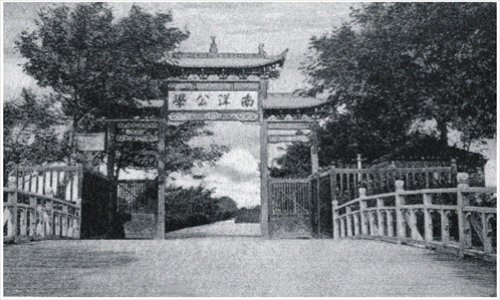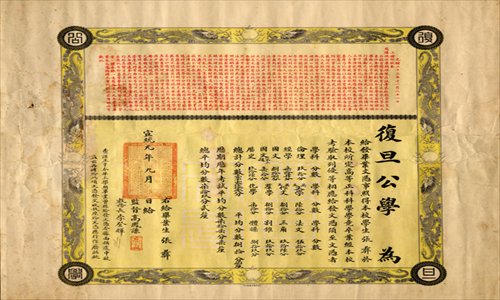High times in higher education

The history of Shanghai Jiao Tong University is inextricably tied to Sheng Xuanhuai (1844-1916), the founder of the university's forerunner institution, the Nanyang Public School. Sheng was born into a family of officials. After sitting the imperial exams three times but failing to obtain the rank of juren (provincial graduate), Sheng lost interest in the system.
With his father's connections, Sheng was then employed by General Li Hongzhang as his aide, becoming his chief economic deputy in 1870. The 26-year-old soon won Li's confidence as he personally handled everything with a down-to-earth, efficient practicality.
Business involvement
In the 1870s, he became involved in the Self-Strengthening Movement (the Qing court's drive to modernize China using foreign skills and technology). Sheng became involved in many of the businesses linked to the movement including the shipping, telegraphy, railway, banking and textile industries.
As he pursued this, Sheng came to realize that China was seriously lacking in skilled personnel familiar with modern technology, foreign languages and management techniques. Traditional studies like the writing of baguwen (the eight-legged essay - a historic style of essay writing) had no purpose in the Self-Strengthening Movement's philosophy.
Sheng set out to revolutionize the traditional education methods in China and to train a new skilled generation. Before moving to Shanghai to further his career, Sheng founded the Beiyang University in Tianjin, the first modern higher education institution in China, in 1895. The following year, under an imperial edict issued by Emperor Guangxu of the Qing Dynasty (1644-1911), Sheng founded the Nanyang Public School in Shanghai, the forerunner of Shanghai Jiao Tong University.
The school was funded by the Ship Business Soliciting Bureau and the Shanghai Telegraph Office, which were both businesses run by Sheng. Every year, these companies gave the school 100,000 taels of silver, like the way many institutions were funded abroad. In those days it was common for schools in Europe to be funded by both private companies and governments.
Tradition as a basis
Sheng Xuanhuai wanted to established a formal college to educate young people in politics, diplomacy and finance. The goal was to learn from the educational methods of Japan and France, but the basis was always to be in traditional Chinese culture.
As a member of the Self-Strengthening Movement, Sheng had seen that the different models of schools launched for the movement could only meet the demand for new technical skills, but did not fundamentally change the structure of Chinese education. Neither could these schools train people who could introduce new management concepts and put them into practice. The establishment of the Nanyang Public School tried to reflect the demands for the new style of education made by the Qing government.
Sheng was the adviser who had proposed this notion to Emperor Guangxu and thus became the school's administrator and its guiding light from 1896 to 1905. As the second higher education institution in China, Nanyang Public School pioneered many aspects of higher education. Four schools were established - the normal school, a school of foreign studies, a middle school and a high school. The normal school was the first of its kind in China and set the foundations for the country's modern normal education system.
Nanyang's normal school had its first admission exams in March, 1897. Thousands of people from all over the country came to sit for the exams. Most were from poor families. After the exams and a strict selection process, 40 students were admitted. The school gave them accommodation, food and other bits and pieces as well paying a monthly allowance of from six to 10 taels of silver based on their grades. Students who excelled academically were given extra payments.
The normal school closed in 1903 but in its seven years, it had educated 71 key students including the leading philosopher and educator Wu Zhihui (1865-1953) and Bai Yayu (1867-1912), the founder of the Geographical Society of China.
The ink bottle affair
But it was an ink bottle that almost closed the entire operation. For thousands of years, Chinese students had been sitting in classrooms, caring little about what was going on outside and only focusing on the imperial exams and their future careers as officials. But at Nanyang Public School, students learned about Western culture and technology, they read foreign magazines, newspapers and books, and became familiar with Western capitalism and democracy. Ideas began fomenting - they could think about opposing feudalism and autocratic oppression and consider democracy and freedom.
Nanyang was a new style of school, but it hadn't completely got rid of the traditional feudal education model. Sometimes the classrooms here were still tied to the old harsh autocratic teaching methods. Some teachers couldn't understand the new philosophies their students were considering. From time to time, there were open hostilities between the teaching staff and the students.
On November 5, 1902, Guo Zhenying, the Class Five teacher, went into his classroom and found a clean but empty ink bottle on his lectern. He immediately suspected the students were mocking him - that the empty ink bottle symbolized that he was incapable of studying or teaching. He tried to discover the culprit but the students said they didn't know who had left the ink bottle there. The furious teacher then ordered two of the students in the front of the class to tell him within three days who had left the ink bottle there, otherwise they would be disciplined severely.
One of the students took the threat seriously and falsely accused another student of the act. On November 3 the school decided to defer to the teacher and dismissed the innocent student. The class protested but the school announced it would proceed with the dismissal.
Inspired by their readings, the class decided to walk out of the school - but not before they had gone to every other classroom in the school and explained why they were doing this and calling for support in their stand against autocracy. Most of the students supported their stand.
The then headmaster Wang Fengzao became involved and said he would expel all the students from that class - without asking for details or explanations. The students were furious and after heated meetings decided that all the students would walk out. Now, seriously embarrassed by the affair, the school asked its most respected teacher, Cai Yuanpei, to mediate.
Cai persuaded the students to postpone their walkout until the school came up with a valid explanation. He then rushed to see the administrator Sheng Xuanhuai, but Sheng refused to receive him, saying he was busy with something important.
So at 10 am on November 16, all the school's students packed their belongings and gathered in the playground. When they discovered there was no and would not be an official response or explanation, they marched out shouting "long live the motherland." Cai Yuanpei also left in anger. All of the school's 200-plus students quit the school that day, leaving the classrooms empty. A few, under pressure from the school authorities and their families, returned later but 145 stayed away.

A new dawn
The ink bottle affair which saw Nanyang Public School's decline in influence saw the creation of another education powerhouse in the city. The Aurora Academy was founded by Ma Xiangbo (1840-1939), a leading Chinese educator. Ma was a patriot familiar with both Chinese and Western studies and a devoted Catholic.
It was Cai Yuanpei who recommended that a group of the students, who had walked out of Nanyang Public School, ask Ma for help. At that time Ma was preparing to open his new school and he accepted these students without hesitation. He rented the old houses of the Xujiahui Observatory from the Catholic Church and hired French priests to teach.
On March 1, 1903, just a few months after the ink bottle affair, the new school opened. Ma Xiangbo named it Aurora, a Sanskrit word meaning China (although in English it means dawn or the ancient goddess of dawn). Ma saw his Aurora Academy as a rising sun shining on the task of bringing education to China.
The courses lasted two years and the only majors at first were literature and science, but later included philosophy and math. After learning about the school, the famous philosopher, journalist and educator Liang Qichao commented, "I feel extremely joyful to see our country with such a well-equipped and orderly private school."
The school was also unique then as it allowed the students to manage themselves. The school's affairs were managed by representatives elected by the students. The Aurora Academy advocated academic democracy and freedom of thought. It aimed to provide a general guidance to students and inspire them to further studies. It emphasized art and science. Within a year 132 students were enrolled.
In the summer of 1904, a new student arrived at the school. The plain-looking Liu Xueyu was originally called Yu Youren but his life was anything but plain. In 1903 he had passed the imperial examinations to become a juren, but he had been branded a revolutionary by the government of the day because of the satirical writings in his book Poetry Drafts from the Hall of Tears and Mockery.
Wanted by the Qing government, Yu fled and sought refuge in Shanghai. With help from Ma Xiangbo, he was enrolled at the Aurora Academy and was exempted from the fees. He called himself Liu Xueyu to avoid trouble.
Ma's education methods won acclaim from the young students, but the Catholic Church was not as happy. In 1905 when Ma Xiangbo was on sick leave, the Catholic Church sent a French missionary to take charge of teaching at the school. It looked as though he was helping Ma but in fact he took over the running of the school.
Soon after he arrived the blonde priest canceled the Confucian holidays and forced the students to take religious classes, sing hymns, pray in the morning and evening and go to church every Sunday. He forbad the discussion of current affairs, the organization of clubs or societies and the reading of any progressive literature.
His regime angered the students and many left in protest - some left carrying the school's name plaque. Ma Xiangbo heard about the upheavals on his sickbed and sided with the students saying he too wanted to disassociate himself from the school.
Direct opposition
The Aurora Academy became an empty shell. But Ma believed that the spirit of the school should be maintained. In direct opposition to the church, he set about opening a new school. Some colleagues suggested they should name the new school Aurora again but others said the name had been tainted and proposed it be called the Shanghai Public School.
It was the new scholar Yu Youren who came up with a compromise. He suggested the school be named Fudan - a word from the line "Heavenly light shines day after day" in The Annotations of Yu and Xia of Scholia of the Collection of Archaic Texts. The word "fudan" also suggests sunrise and the revival of China. On May 27, 1905, with 10,000 taels of silver donated by Zhou Fu, the governor general of Jiangsu, Anhui and Jiangxi provinces, a temporary campus in Wusong was opened for Fudan College, the forerunner of Fudan University. Ma was the president.
The Aurora Academy had closed when the students left but reopened in the same year as Fudan College was established. In 1928 the school changed its name to the Aurora University but in 1952, as the country revamped higher education, the university was officially closed down with different departments merging into Fudan University, Shanghai Jiao Tong University and the East China University of Political Science and Law among others.